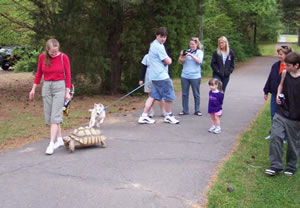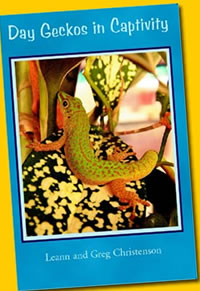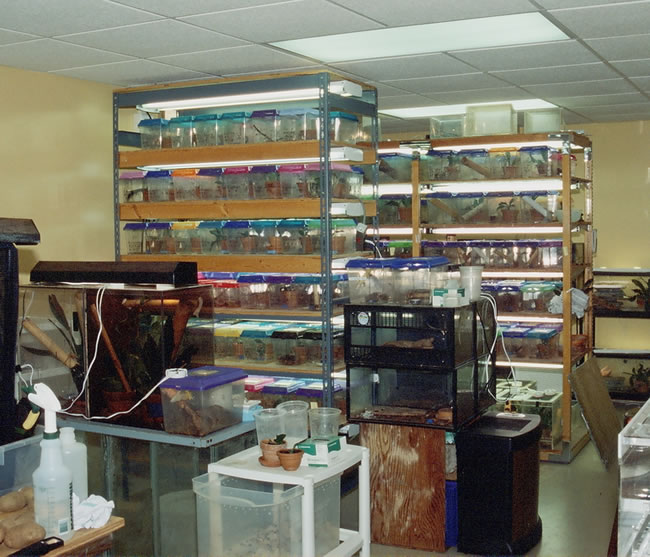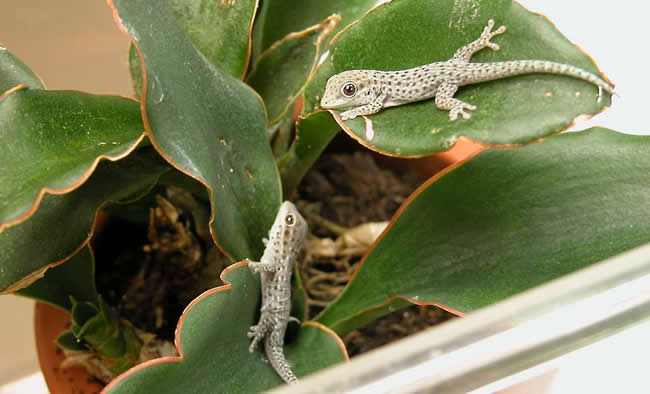[ad#superworms]
Gecko Time is pleased to present an interview with Leann and Gregg Christenson of Leaping Lizards. They are keepers, breeders and tireless advocates for Day Geckos (Phelsuma). Authors of Day Geckos in Captivity, this couple has extensive experience with Day Geckos. This is a must read interview for anyone interested in day geckos.
Thank you for agreeing to do this interview for Gecko Time. Could you tell us something about how you got started keeping day geckos and what your collection is like now?
My husband is to blame for this whole enterprise. When I met Greg, the most I knew about reptiles was that they were cold-blooded. Greg, on the other hand, had been messing with reptiles his entire life. In his childhood he was into observing reptiles in the wild. His father was in the Navy, so Greg had lots of opportunities to observe reptiles from across the U.S. Soon after we met, someone in my family found out Greg was into reptiles and gave us this adult female iguana. As soon as Greg discovered I was willing to clean cages, he married me. To this day I wonder if this was one of the top ten reasons he married me. Soon I was cleaning the cages of a growing number of Phelsuma: the gecko of Greg’s dream. He was nuts about these. At our peak, we’ve had more than 300 geckos, 28 species of Phelsuma, 12 tamed tokays, and numerous other reptiles including turtles. We custom built an environmentally controlled gecko room for maximum benefit. Somewhere during this time Greg and I have carved out a nice reputation for writing about reptiles. Besides our book, we have written articles for Reptiles Magazine, Reptile Care (European magazine), and Chit Chat (Global Gecko Association newsletter) plus a few other on-line reptile websites. At present we have slendered down our collection to just under 200. We made a decision to specialize in the very difficult to keep, rare Phelsuma. Our goal is to better understand their husbandry and share it with other keepers.
What are some of the challenges of breeding day geckos?
Phelsuma are territorial so many have to be kept individually or in pairs only. This makes for a lot of enclosure cleaning. Yuck, my least favorite job. Phelsuma are secretive, sensitive and environmentally delicate. Building a suitable room just for them has make a huge impact on our ability to keep the more difficult species (this special room also brought our electric bill down immensely). Twice a day care, minimum, is essential. Since they don’t drink from bowls, misting them by hand is necessary. On the positive side, it’s a good opportunity to look at them twice a day so I can better track their health. Probably the biggest bummer of all, Greg and I can’t just get away for a day or take vacations on the spur of the moment. We have to hire, beg, plead to arrange a small army of people to care for everyone during our absence.
What do prospective day gecko keepers need to know about lighting?

There is so, so much to know about lighting. So much that I think a good day gecko keeper needs to start at the very essential aspect of lighting: how to read a light bulb. What! Read a light bulb? Absolutely. A keeper should know the difference between a 50 watt and a 150 watt, a compact fluorescent and a incandescent, a T8 and a T5, UVB vs. UVA, and even more. Once a keeper knows the qualities of a bulb then they can begin to make sound decisions about which bulb will work in what situation. Of course, a keeper needs to know what lighting their gecko needs. For day geckos, lighting can be about UV-B production, color development, color display, and/or providing heat in an enclosure. Interestingly enough, with day geckos, there is a choice of using UV-B proving lights or not. We choose not to use UV-B lighting and instead we provide dietary vitamin D3. We choose bulbs with a high color rendering index and high light intensity. I would say the more a keeper knows about the qualities of light, the better they can provide for their geckos.
Could you describe an average day at your facility?
I work at home so this is Monday – Sunday. The collection got so big that one of us had to stay home and Greg voted that it be me. 7:00 a.m. Water geckos, feed insects (crickets, mealworms, super worms), check environment, check for hatchings. 8:00 a.m. Check e-mails for gecko correspondence. 10:00 a.m. – 2:00 p.m. Feed geckos, feed and water turtles, check for eggs, clean enclosures, clean gecko room, clean cricket enclosures, check cricket eggs (I raise 80% of my own crickets and bugs), make adjustments to environments (add water to humidifier, clean filters, clean fans), attend to any sick geckos, maintain breeding and hatching records. 2:00 p.m. Go outside and change water for Frankie, our 60 pound sulcata tortoise, and give him a carrot and cuttlebone. 7:00 p.m. Water geckos, feed insects (crickets, mealworms, super worms), check environment, check for hatchings, check for eggs. 10:00 p.m. Check environment.
What special projects are you working on this year?
As I mentioned, we are working with the more difficult Phelsuma species. We are doing this in cooperation with several other keepers. We are having some really great success. Some of these special species we are working with include Phelsuma cepediana, Phelsuma inexpectata, Phelsuma barbouri, and Phelsuma breviceps: we are thrilled with the progress on these. Recent past projects included Phelsuma mutablis and Phelsuma ornata: these projects ended when the last males died (both from old age) and we were unable to replace them. We still breed another six species but those are much more common here in the U.S.
Do you have any favorite day geckos? What are they and what do you like about them?

I have to admit that although I love day geckos, my heart belongs to my 60 pound sulcata tortoise, Frankie. Where my day geckos only love me for the crickets I bring them, Frankie loves me for more than just carrots: we are great pals. Frankie has inspired me to write Frankie’s Tortoise Tails, a very popular blog at www.turtletimes.com and distributed through Sulcata Station’s Yahoo group and Arizona Sulcata Turtles. Frankie has become quite famous, as much as a sulcata tortoise can be, and provides me a much needed break from the secretive and shy Phelsuma. Of course I am very fond of my five tamed tokays: Bester, Demi, Deo, Frodo and Dyson.
Is there anything else you think is important for people who are interested in Day Geckos to know?
The key to knowing Phelsuma is the environment. Environment covers: lighting, humidity, photo period, temperature, and air movement. Many keepers overlook one or more of these important factors. I would also suggest a good understanding of reptile nutrition.
Buy their book!

Leann & Gregg Christenson share their innovative approach to keeping and breeding day geckos for enthusiasts as well as those who simply want to learn more about these fascinating reptiles. Discusses in detail behavior and captive living, obtaining and caring for geckos, diet, reproduction, raising juveniles, health and taxonomy. Individual species accounts provide full-color photographs, scientific and common names, vivarium type, skill level, distribution, size, eggs, description and care. Full-color photographs. Buy their book today.




how much are phelsuma Breviceps ?
$500-$800 per pair, when available.